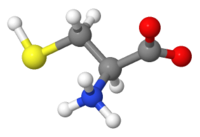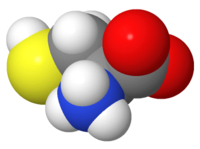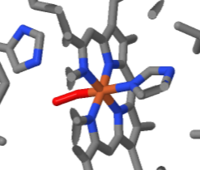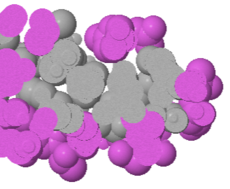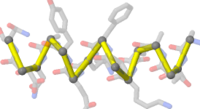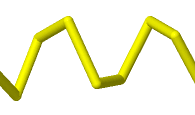Introduction to molecular visualization: Difference between revisions
Eric Martz (talk | contribs) |
Eric Martz (talk | contribs) |
||
| Line 41: | Line 41: | ||
===Simplified Schematic Representations=== | ===Simplified Schematic Representations=== | ||
Simplified representations such as '''[[Backbone_representations|backbone traces or ribbons/cartoons]]''' are very helpful in understanding structure when it comes to large molecules such as proteins, DNA, RNA and their complexes. These representations are available under the ''representations'' tab in Proteopedia's [[Scene Authoring Tools]], as well as in the ''Views'' tab in [[FirstGlance in Jmol]]. | <table align="right" class="wikitable" style="text-align:center;margin: 0px 0px 0px 16px;"><tr><td> | ||
[[Image:Helix-bb-wf.png|200px]] | |||
</td><td> | |||
[[Image:Helix-backbone.png]] | |||
</td><td> | |||
[[Image:Helix-trace.png]] | |||
</td></tr><tr><td> | |||
Alpha carbon<br>backbone trace | |||
</td><td> | |||
Alpha carbon<br>backbone trace | |||
</td><td> | |||
Smoothed<br>backbone trace | |||
</td></tr><tr><td colspan="3"> | |||
<span style="background-color:black;padding:5px 8px 1px 6px;font-size:140%;"><b><font color="#bbb">C</font> <font color="white">H</font> <font color="red">O</font> <font color="#58f">N</font> <font color="yellow">S</font></b></span>Simplified representations such as '''[[Backbone_representations|backbone traces or ribbons/cartoons]]''' are very helpful in understanding structure when it comes to large molecules such as proteins, DNA, RNA and their complexes. These representations are available under the ''representations'' tab in Proteopedia's [[Scene Authoring Tools]], as well as in the ''Views'' tab in [[FirstGlance in Jmol]]. | |||
==Color Schemes for Macromolecules== | ==Color Schemes for Macromolecules== | ||
Revision as of 01:49, 15 August 2018
Molecular visualization means looking at molecular models in order to explore and understand them. Molecular visualization does not necessarily involve molecular modeling, which means creating molecular models, or changing the composition or configurations of existing models. Here we will be dealing primarily with models of macromolecules (protein, DNA, RNA, or their complexes).
Representations of Molecular ModelsRepresentations of Molecular Models
Atomic RepresentationsAtomic Representations
|
C H O N S | ||
Atomic representations (displays, renderings) include ball-and-stick, stick (wireframe), and spacefilling. The 20 amino acids are here represented in each of these 3 ways, and also illustrated in this page about Glycine. These representations show positions of atoms and covalent bonds. Such representations are useful for looking at atomic detail, but become too cluttered to be useful for visualizing peptides or protein chains.
Ball and stick is one option in the representations tab of Proteopedia's Scene Authoring Tools. Another is stick, also called wireframe.
In FirstGlance in Jmol, you can isolate a small portion of a large structure, and then display it as sticks (Vines/Sticks in the Views tab). Or, rather than isolating it, which hides everything else, you can center it and then turn on slabbing.
SlabbingSlabbing
|
Slab showing heme (1hho) |
Slab showing hydrophobic |
A useful way to see atomic details of a small part of a large macromolecular model is to center the moiety of interest, and then cut away the front and back portions of the molecule. This is called slabbing since one is, in effect, looking at a slab cut out of the larger model. Slabbing is also useful to see buried structures and their environments, such as the hydrophobic core of a protein domain. Slabbing can be done using FirstGlance in Jmol: In the Views tab, use Center Atom to center the region of interest, and then click the Slab button. Further instructions will appear automatically.
Simplified Schematic RepresentationsSimplified Schematic Representations
|
Alpha carbon |
Alpha carbon |
Smoothed |
|
C H O N SSimplified representations such as backbone traces or ribbons/cartoons are very helpful in understanding structure when it comes to large molecules such as proteins, DNA, RNA and their complexes. These representations are available under the representations tab in Proteopedia's Scene Authoring Tools, as well as in the Views tab in FirstGlance in Jmol. Color Schemes for Macromolecules
| ||
